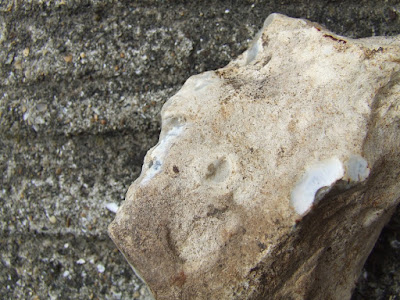Portable Rock Art
finds have huge resistance in some online communities, just pop along
to a forum of native American artefacts, post a picture of a worked
stone showing some resemblance to a creature, sit back and watch the
fireworks. Its not just people on arrowhead forums that are in denial
here, there is professional resistance to the idea, and even suppression
of the evidence and attempts to block mainstream acceptance.
Well perhaps its just avocational archaeologists with overwhelming evidence such as myself that are met with such ignorance? No, here is an excerpt from a recent article from PCN magazine, the article sheds light on a professionally authenticated bear effigy found in a Clovis cache, publication of which has been 'held up for 12 years.' but the excerpt is about the highly regarded Dr. Virginia Steen-McIntyre, and ignorance of any facts that shed serious doubt on the mainstream narrative.
'For
Dr. Steen-McIntyre resistance to her evidence of pre-Clovis artistic
people (confirmed by eminent USGS geologists and chemists and even the
designer of NASA’s Apollo missions moon core samplers and instructor of
the astronauts, not to mention discoverer of one of the oldest human
fossils in the Western Hemisphere) has persisted well past ‘50 years.’
It is unfortunate a low-integrity field whose dogmatic resistance to
evidence that could change our picture of prehistory led to the
eventual destruction of the 250,000-year old Hueyatlaco early man site
in Mexico. Such—among many other documented examples—is why we
periodically remind readers the field cannot be trusted as a
‘science.’'
You can download the full issue of, including the article here, but I highly recommend that you subscribe to the PCN Magazine free mailing list as well. I am very grateful to have Dr. Steen-McIntyre work on my article to make it fit for publication in PCN. My PCN article, and the full version on this blog)
Above: This is the bear effigy found by Dr. Mark Corbitt amongst a confirmed Clovis cache.
Diatom dating was used to confirm the age of the cache as Clovis, but that does not mean the find is a Clovis artwork, its entirely possible that the find is from a much earlier date, bore an interesting bear likeness and so was added to the Clovis cache. Obviously I would agree this is a piece of portable rock art, but is it a figure stone by my definition? (Figure stones are possibly much older and I suggest often have a purpose and a common topology) The find does have some similarities with my own finds here in the UK:
1. The flake removal is precise and minimal.
2. A natural flint nodule with some desired visual features has been selected as the medium.
3. Cortex carving has been used to add finer details. (cortex is the outer casing of flint nodules)
4. The subject is that of a bear, in profile, commonly found in my own finds, and recognized by many as a common subject of figures stones.
I am not 100% convinced this is an ancient figure stone (I would love to see more pictures), although I can see a possible partial glyph of a long necked water bird (upper middle). I would like to see a convincing Proboscidean front half and the head profile of an ape or monkey like depiction to be 100% on this, or the signature thumb or hand holding a rock glyph so often found in Palaeolithic flint tools, but completely ignored by the mainstream........






